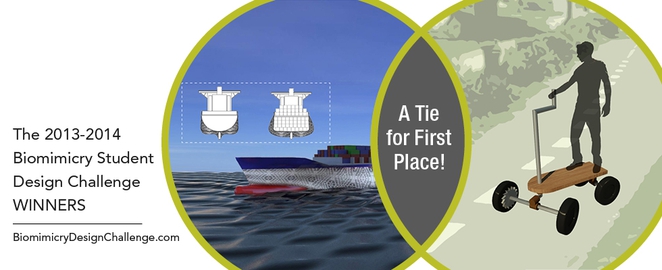
The Biomimicry 3.8 Institute announced a tie for the top prize of the 2013-2014 Student Design Challenge. First places goes to a team of students from McGill University for a ship redesign inspired by fish swim bladders and to a team from Universidad Autónoma de Yucatán for an millipedes-inspired transportation alternative.
The McGill team chose to work on the problems created by ballast water. Heavy cargo ships take on water when they are empty, and release water as they are filled, to help maintain a consistent level of buoyancy. The problem with this system is that a lot more than water gets pulled into the ship. Many types of plants and animals are transported too, resulting in problems with invasive species.
The Air Ballast Biomimetic Cargo Ship took first place for its use of air instead of water. "We started looking at unique features of aquatic animals who would face the same buoyancy challenges as man-made designs would,” said Naomi Eterman, a member of the McGill Team.
“Just coming up with a problem that is both interesting and inspiring for everybody in the team was in itself a challenge,” said Laurie Bouchard, one of the students from the McGill team. “We came up with a lot of ideas, but there was really something about he ballast water problem that made us want to go in that direction.”
"Our research process focused on both the biomaterials that provide buoyancy for living organisms (swim bladder, cuttlebone) and physiology that operates under extreme pressures (seal trachea) and provide motility (whale fines, tubercles) in order to understand how animals cope with living submerged under water,” said Phil Zimny, also a team member. “We first attempted to emulate these structures, but soon found that the need to transport cargo many times the mass of the vessel is uniquely a human problem. Therefore, we needed to build upon these raw materials in order to come up with the most efficient design possible.”
The team from Universidad Autónoma de Yucatán tackled the problem of transporting people without cars. They designed a non-motorized transport device called MOCAN. “We decided that the wave motion of millipedes and the serpentine movement of snakes were the best strategies,” Diana Carolina Vega Basto told TreeHugger. “This device works with human force; you only need to move the lever and the wheel axel propel it forward in a wave motion.”
Both teams created models for the design challenge; the Canadian team worked with digital modeling and the Mexican team also produced a physical small-scale model. Vega Basto said that her team plans to create a human-scale model in the future, because they want to patent the design. “We made several prototypes before we came out with the final design,” said Vega Basto.
Both teams are highly interdisciplinary, including students studying biology, architecture, chemical engineering, biochemistry and civil engineering.
Alexander Grant of the McGill team wait that coming up with a solvable problem was one of the challenges of the design competition. “Our ultimate strategy to overcome these challenges was to use a low tech high intelligence method where we tried to avoid using technical solutions,” he said. The team wanted to avoid “piling engineering on top of engineering” and instead looked to problem-solve on a more fundamental level. “We think that our design goes back to the root of why ballast is needed at all, and this sort of creativity and philosophical strategy was very satisfying for us!”
The above story is based on materials by Treehugge.
Note: Materials may be edited for content and length. For further information, please contact the source cited above.
Copyright © 2024 International Society of Bionic Engineering All Rights Reserved
吉ICP备11002416号-1



 Attachment:
Attachment:






